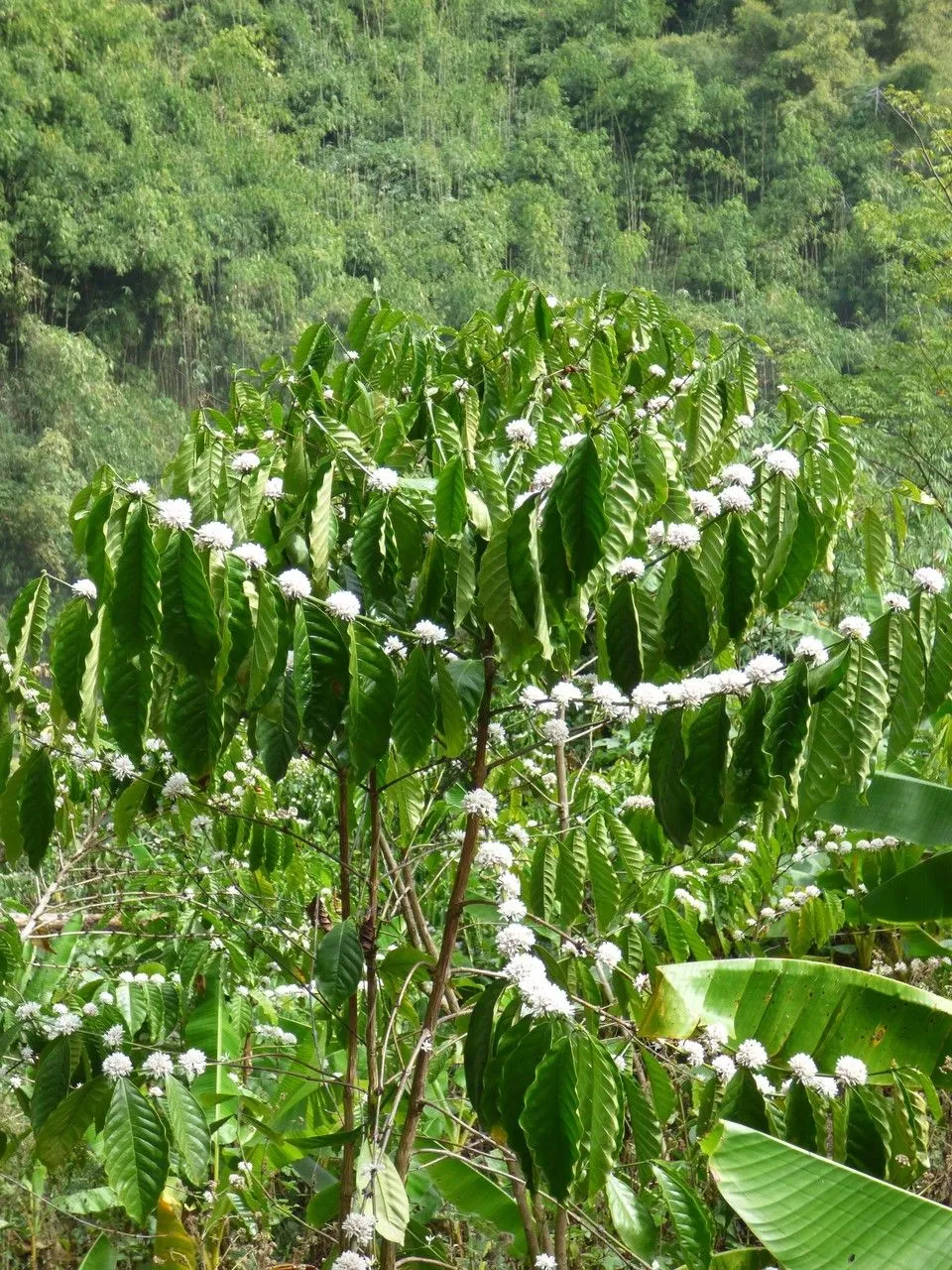
Author: L.
Bibliography: Sp. Pl.: 172 (1753)
Year: 1753
Status: accepted
Rank: species
Genus: Coffea
Vegetable: False
Observations: E. South Sudan, SW. Ethiopia, N. Kenya (Mt. Marsibit)
Arabian coffee, scientifically known as Coffea arabica, is a significant species within the coffee family, Rubiaceae. Esteemed for its distinct flavor and lower caffeine content compared to other coffee species, Coffea arabica holds a prestigious position in the global coffee industry.
Historically, Coffea arabica has a storied past, with its origins traced to the regions of Eastern South Sudan, Southwestern Ethiopia, and Northern Kenya, specifically on Mount Marsabit. These areas present the optimal climatic and soil conditions conducive to the growth of this revered plant. The species was first described by the renowned botanist Carl Linnaeus in 1753, as cited in his seminal work, “Species Plantarum.”
The coffee plant itself is a perennial shrub that can grow between 2.5 to 4.5 meters in height. Its dark green leaves, complemented by white, sweetly-scented flowers, give way to cherry-like fruits. The seeds of these fruits, known as coffee beans, are the primary component used in coffee production. Compared to other coffee species such as Coffea canephora (commonly known as Robusta), Arabica beans are generally favored for their smooth, complex flavor profile and higher acidity.
Cultivating Coffea arabica requires specific environmental conditions to thrive. These include high altitudes, a moderate climate with consistent temperatures between 15-24°C, and well-drained, fertile soil enriched with organic matter. Given these exacting requirements, the plant is primarily grown in tropical highlands around the world, including countries in Latin America, Southeast Asia, and Africa’s coffee belt.
The significance of Coffea arabica extends beyond its economic value. This plant plays an essential role in biodiversity and ecosystem stability in the regions where it is endemic. Traditional cultivation practices often involve shade-grown methods, which help preserve local flora and fauna, promoting a balanced and sustainable environment.
In conclusion, Coffea arabica, or Arabian coffee, is celebrated not only for its superior quality and contribution to the global coffee market but also for its ecological benefits and rich historical roots. Its cultivation and production continue to be a vital part of the agricultural landscape in many countries, providing livelihoods for millions of people worldwide.
Eng: arabian coffee, coffee, arabica coffee, coffee-tree, coffeetree
Deu: arabicakaffee, bergkaffee, kaffeestrauch, arabischer kaffeebaum, arabischer kaffeestrauch
Por: arabian-coffee, cafeeiro, café, café-arábica, caféeiro
Swe: arabiskt kaffe
Spa: cafeto arábico, cafeto de arabia
Fra: caféier d’arabie
Afr: koffieboom
En: Arabian coffee, Coffee, Coffeetree, Arabica coffee, Սուրճ Արապիքա, Coffee-tree
Af: Koffieboom, Koffie
Ar: بن عربي
Hy: Սուրճ արաբիկա
Az: Ərəb qəhvəsi
Bg: Арабско кафе
Zh: 咖啡
Cv: Кофе Арабика
Cs: Kávovník arabský
Da: Ægte Kaffe
Eo: Araba kofeo
Et: Araabia kohvipuu
Fj: Kofe, Kove
Fi: Arabiankahvi, Kahvi
Fr: Caféier d’Arabie, Caféier
De: Arabicakaffee, Bergkaffee, Kaffeestrauch, Arabischer Kaffeebaum, Arabischer Kaffeestrauch, Arabica-Kaffee
He: קפה ערביקה
Hu: Arab kávé
Id: Kopi arabika
Kn: ಅರಾಬಿಕ ಕಾಫಿ
Ko: 커피나무
Lt: Arabinis kavamedis
Ml: കോഫി അറബിക
Mi: Kaope, Kaope Maori
Fa: قهوه عربی
Pl: Kawa arabska
Pt: Caféeiro, Arabian-coffee, Cafeeiro, Café, Café-arábica
Pt-br: Café, Cafeiro
Qu: Kaphiy yura
Ru: Кофе аравийский
Sg: Kâfe
Sd: ڪافي عربيڪا
Sk: Kávovník arabský
Es: Cafeto arábico, Cafeto de Arabia, Café, Cafeto, Arabski kavovec
Sv: Arabiskt kaffe
Ty: Taofe
Zh-tw: 小果咖啡
To: Kofi
Uk: Арабіка
Vi: Cà phê chè
Taken Feb 24, 2016 by Daniel Barthelemy (cc-by-sa)
Taken Feb 24, 2016 by Daniel Barthelemy (cc-by-sa)
Taken May 11, 2019 by Mélanie bévière (cc-by-sa)
Taken Jan 18, 2018 by Hugo SANTACREU (cc-by-sa)
Taken May 30, 2019 by Salman Abou Hassan (cc-by-sa)
Taken Feb 24, 2016 by Daniel Barthelemy (cc-by-sa)
Taken Feb 23, 2016 by Daniel Barthelemy (cc-by-sa)
Taken Feb 24, 2016 by Daniel Barthelemy (cc-by-sa)
Taken Feb 23, 2016 by Daniel Barthelemy (cc-by-sa)
Taken Oct 1, 2019 by Marie-Eve Lemieux (cc-by-sa)
© copyright of the Board of Trustees of the Royal Botanic Gardens, Kew.
© copyright of the Board of Trustees of the Royal Botanic Gardens, Kew.
© copyright of the Board of Trustees of the Royal Botanic Gardens, Kew.
Taken Dec 27, 2019 by rustam roedy (cc-by-sa)
Taken Jan 11, 2020 by Dácio Dácio (cc-by-sa)
Taken Aug 3, 2019 by Bobert (cc-by-sa)
Taken Oct 1, 2019 by Marie-Eve Lemieux (cc-by-sa)
Taken Jan 15, 2020 by Ananas Ananas (cc-by-sa)
Taken Nov 17, 2014 by Tela Botanica − Liliane Roubaudi (cc-by-sa)
Taken Mar 1, 2017 by Tela Botanica − Liliane ROUBAUDI (cc-by-sa)
Taken Mar 13, 2021 by WillBe (cc-by-sa)
Taken Jan 18, 2018 by Hugo SANTACREU (cc-by-sa)
Taken Mar 4, 2021 by Sébastien TRASBOT (cc-by-sa)
Taken May 15, 2014 by Tela Botanica − Céline PIRAT (cc-by-sa)
Taken Apr 14, 2015 by Tela Botanica − Hugo SANTACREU (cc-by-sa)
Taken May 15, 2014 by Tela Botanica − Céline PIRAT (cc-by-sa)
Taken Jun 6, 2021 by Fernando da Luz Schmidt (cc-by-sa)
Taken Mar 4, 2021 by Sébastien TRASBOT (cc-by-sa)
Taken Mar 26, 2021 by Ribeiro Conceição (cc-by-sa)
Taken May 15, 2014 by Tela Botanica − Céline PIRAT (cc-by-sa)
Taken Feb 28, 2015 by Tela Botanica − Waldo Schafli (cc-by-sa)
Taken Jan 8, 2022 by a Angie (cc-by-sa)
Taken Mar 29, 2021 by An Pan (cc-by-sa)
Growth form: Multiple Stem
Growth habit: Tree, Shrub
Growth rate: Moderate
Ph maximum: 7.5
Ph minimum: 4.0
Family: Myrtaceae Author: (F.Muell.) K.D.Hill & L.A.S.Johnson Bibliography: Telopea 6: 402 (1995) Year: 1995 Status:…
Family: Rubiaceae Author: Pierre ex A.Froehner Bibliography: Notizbl. Bot. Gart. Berlin-Dahlem 1: 237 (1897) Year:…
Family: Sapindaceae Author: Koidz. Bibliography: J. Coll. Sci. Imp. Univ. Tokyo 32(1): 38 (1911) Year:…
Family: Asteraceae Author: A.Gray Bibliography: Pacif. Railr. Rep.: 107 (1857) Year: 1857 Status: accepted Rank:…
Family: Fabaceae Author: Medik. Bibliography: Vorles. Churpfälz. Phys.-Ökon. Ges. 2: 398 (1787) Year: 1787 Status:…
Family: Aspleniaceae Author: (Cav.) Alston Bibliography: Bull. Misc. Inform. Kew 1932: 309 (1932) Year: 1932…